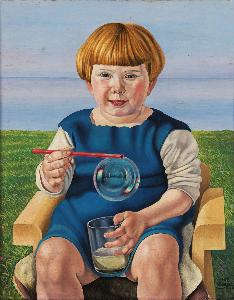Natale Bentivoglio Scarpa
Natale Bentivoglio Scarpa;Cagnaccio Di San Pietro
Style: Magic Realism;
Place: Desenzano Del Garda
Born: 1897
Death: 1946
Biography:
, also known as Cagnaccio di San Pietro, was a renowned Italian painter born on January 14, 1897, in Desenzano del Garda. His artistic training began at the Academy of Fine Art in Venice, where he studied under Ettore Tito.
Early Career and Style
Cagnaccio's early paintings were characterized by a Futurist idiom, but by the early 1920s, he had adopted a smoothly brushed, nearly photographic style. This transition marked the beginning of his journey into the realm of magic realism. His work includes portraits, nudes, still lifes, scenes of popular life, and religious pictures, showcasing the influence of German painters from the New Objectivity movement.
Notable Works
One of Cagnaccio's most notable works is After the Orgy, created in 1928. This painting features three nude women asleep on a floor littered with wine bottles, playing cards, and cigarettes, resulting in a more depressing than titillating effect. The clinical realism of this work is also evident in his still lifes, which often represent crabs, lobsters, or glass objects painted with chilly precision.
Later Life and Legacy
Cagnaccio's health began to disintegrate in the 1940s, and he spent the war years hospitalized in Venice. He passed away on May 29, 1946. Despite his untimely death, Cagnaccio's contributions to the world of magic realism remain significant. His work can be found in various museums and collections, including the Pinacoteca Comunale in Recanati, Italy. Key aspects of Cagnaccio's style include:
- His use of smooth brushstrokes to create a sense of realism
- The influence of German painters from the New Objectivity movement on his work
- The clinical precision with which he painted still lifes
- The emotional and psychological depth conveyed in his portraits and scenes of popular life
For more information on Cagnaccio's work, visit Natale Bentivoglio Scarpa. To explore the world of magic realism and its notable artists, check out Cagnaccio di San Pietro, which features an impressive collection of Italian and European paintings from the 14th to the 19th century.





